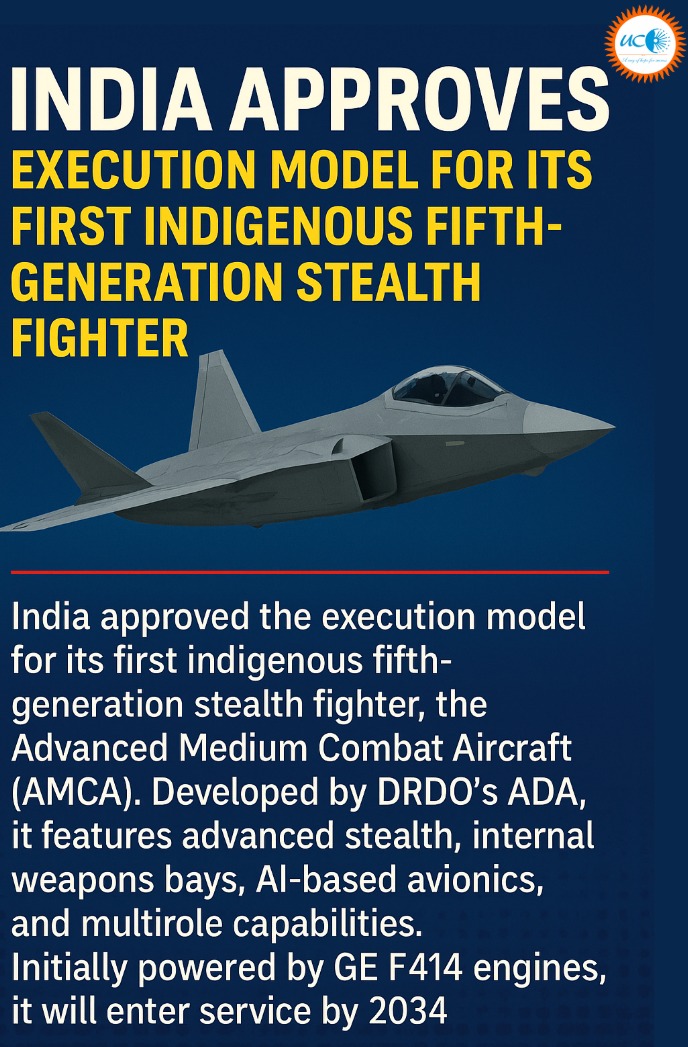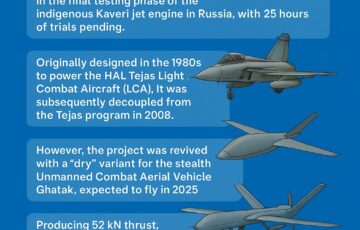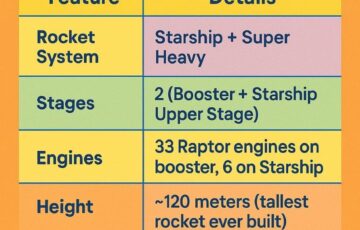India Clears AMCA Execution Model for 5th-Gen Jet
India Approves Execution Model for AMCA: A Major Leap Toward Indigenous Fifth-Generation Fighter Capability
On May 27, 2025, the Government of India’s Cabinet Committee on Security approved the execution model for the Advanced Medium Combat Aircraft (AMCA) program—marking a historic step in India’s defense self-reliance journey. This initiative will lead to the development of India’s 5th generation fighter, aligning with the national mission of Atmanirbhar Bharat and elevating India’s status in the global aerospace arena. The AMCA full form, Advanced Medium Combat Aircraft, represents a significant milestone in India’s quest to develop its own fighter aircraft capabilities and establish itself as a producer of advanced stealth fighter aircraft.
What is AMCA?
The Advanced Medium Combat Aircraft (AMCA) is a next-generation multirole fighter aircraft being developed by the Aeronautical Development Agency (ADA) under the Defence Research and Development Organisation (DRDO). Designed to fulfill future air superiority, deep strike, and electronic warfare roles, the AMCA fighter jet will significantly upgrade India’s air combat capability. This project showcases India’s commitment to Atmanirbharta in aerospace and strengthens its position as a developer of cutting-edge fighter aircraft technology, solidifying its status as a producer of India 5th generation fighter.
Key Features of the AMCA
- Stealth Design: The AMCA incorporates a low radar cross section (RCS) with radar stealth shaping, radar-absorbent materials, and internal weapon bays, making it a true stealth fighter aircraft.
- Multirole Capabilities: It will perform air dominance, ground-strike, and surveillance missions, including deep penetration missions.
- AI-Based Avionics: Advanced glass cockpit interfaces and autonomous mission handling through artificial intelligence.
- Internal Weapons Bay: This design helps maintain stealth by storing weapons inside the fuselage.
- Supercruise Capability: Designed for sustained supersonic speeds without afterburners in later versions.
- Sensor Fusion: Integrates data from various onboard and offboard sensors, including distributed passive sensors, for improved situational awareness.
- Advanced Materials: Extensive use of composite materials for reduced weight and enhanced stealth characteristics.
- Electronic Warfare Suite: Sophisticated electronic warfare capabilities for enhanced survivability in contested airspace.
- Directed Energy Weapons: Potential integration of directed energy weapons in future variants.
Development and Engine Details
The initial versions of the India 5th generation fighter, AMCA, will be powered by General Electric F414 engines, the same engine used in India’s Tejas light combat aircraft Mk2. The General Electric F414 engine is known for its reliability and performance, making it an ideal choice for the AMCA’s initial variants. However, as part of the indigenous development efforts, a fully indigenous engine is planned in collaboration with domestic partners for later versions, enhancing strategic autonomy in propulsion technology. The AMCA engine development is a crucial aspect of the program, aimed at achieving complete self-reliance in aero-engine technology for this advanced stealth fighter aircraft.
Indigenous Collaboration and Private Sector Role
This project marks a shift toward a consortium model involving DRDO, public sector undertakings like Hindustan Aeronautics Limited (HAL AMCA), and private Indian defense firms. This model ensures faster development, industrial participation, and robust supply chain creation within India’s domestic aerospace ecosystem. The indigenous development approach not only boosts the country’s technological capabilities but also aligns with the broader goal of self-reliance in defense production, particularly in the realm of stealth fighter aircraft.
Timeline and Production
The AMCA prototype development is expected to complete development and testing by 2030, with the AMCA first flight targeted shortly after. Induction into the Indian Air Force is projected by 2034. The IAF is expected to induct around 120 AMCA units in phases, starting with AMCA Mk1 (using imported engines) followed by AMCA Mk2 with indigenous propulsion. Recent AMCA updates suggest that the AMCA final design phase is nearing completion, paving the way for prototype construction. This AMCA update indicates significant progress in India’s 5th generation fighter aircraft program, bringing the nation closer to fielding its own stealth fighter aircraft.
Strategic Significance
With the AMCA, India joins an elite group of countries operating fifth-generation fighter jets, such as the:
- F-22 Raptor and F-35 Lightning II (USA),
- Sukhoi Su-57 (Russia),
- Chengdu J-20 (China).
This positions India as a serious player in next-generation aerial warfare technology, reducing dependency on foreign suppliers and enhancing the country’s global strategic standing. The AMCA program, as a flagship Bharat project, demonstrates India’s growing prowess in advanced military aviation and solidifies its status as a developer of India’s 5th generation fighter aircraft.
Alignment with National Missions
The AMCA project is in line with:
- Atmanirbhar Bharat Abhiyan – promoting indigenous defense production and Atmanirbharta in aerospace.
- Make in India – boosting manufacturing and innovation in the domestic aerospace ecosystem.
- Defense Export Strategy – opening avenues for future exports of advanced military aircraft, including stealth fighter aircraft.
Conclusion
The approval of the AMCA execution model signifies India’s strategic commitment to developing advanced aerospace technology, nurturing a robust domestic industrial base, and enhancing national security and global standing. As India’s first indigenous aircraft in the fifth-generation category, the AMCA represents a quantum leap in Indian defence capabilities. This multirole combat aircraft not only showcases India’s technological prowess but also cements its position as a rising power in war jet development. While the exact number of how many fighter jets India has is classified, the addition of the AMCA to India’s fleet will significantly enhance its air power capabilities. The AMCA, as India’s 5th generation fighter and a true stealth fighter aircraft, will undoubtedly impact the answer to the question of how many fighter jets does India have, marking a new era in the country’s aerospace and defense sectors and solidifying its position as a developer of advanced war jets.












